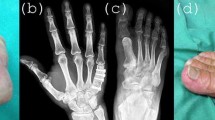Summary
Massive bone allografts from cadavers have been sterilised by γ-radiation from radioactive cobalt at a dose of 25,000 gray (Gy). The biological effects of radiation are discussed. Human cortical bone showed an acceptable 20% decrease in strength on bending tests after 27000 Gy irradiation, but higher doses are more damaging and should be avoided. The procurement protocol used at the Cochin Hospital is described, and the importance of dosimetry and record-keeping emphasised. The clinical results of 150 massive bone allografts are reported. The infection rate was low. The evolution of the graft in each type of reconstruction is analysed and appears to be comparable to non-irradiated allografts. Very few complications occurred after composite reconstructions in the lower limb. Pelvic reconstructions had the highest complication rate, but most were not related to the use of the allograft.
Résumé
Les allogreffes osseuses massives prélevées sur des cadavres ont été stérilisées par rayons γ issus de cobalt radio-actif à la dose de 25.000 gray (Gy). Les effets biologiques des radiations sont discutés. L'os cortical humain montre une diminution acceptable de 20% de résistance aux tests d'inflexion après une irradiation de 27.000 Gy mais les doses supérieures détériorent l'os de façon plus importante et doivent être évitées. Le protocole de prélévement utilisé à l'Hôpital Cochin est décrit et l'importance de la dosimétrie ainsi que de la tenue des dossiers mise en évidence. Les résultats cliniques de 150 allogreffes d'os massif sont rapportés. Le taux d'infection est bas. L'évolution de la greffe dans chaque type de reconstruction est analysée et apparaît comparable à celle des greffes non irradiées. Peu de complications se sont manifestées après reconstruction composite du membre inférieur. Les reconstructions pelviennes ont le taux le plus élevé de complications mais habituellement sans rapport avec l'utilisation des allogreffes.
Similar content being viewed by others
References
Basset AL, Packard AJ Jr (1959) A clinical essay of cathode ray sterilized cadaver bone grafts. Acta Orthop Scand 28: 198–211
Bright R, Burstein A (1978) Material properties of preserved cortical bone. Trans Orthop Res Soc 3: 210
Brown KLB, Cruess RL (1982) Bone and cartilage transplantation in orthopaedic surgery. J Bone Joint Surg [Am] 64: 54–57
Bruwell RG, Gowland G (1962) Studies in transplantation of bone: III. The immune responses of lymph nodes draining components of fresh homogenous bone treated by different methods. J Bone Joint Surg [Br] 44: 131
Darbord JC, Laizier J (1987) A theoretical basis for choosing the dose in radiation sterilization of medical supplies. Inte Pharmaceutics 37: 1–10
De Vries PH, Badgley CE, Hartman JT (1958) Radiation sterilization of homogenous bone transplants utilizing radioactive cobalt. J Bone Joint Surg [Am] 40: 187–203
Fitch FR, Doolan PT, Dwyer WM, Halls NA, Tallentire A (1985) Towards microbiological quality assurance in radiation sterilization processing: simulation of the radiation inactivation process. J Appl Bacteriol 58: 307–313
Komender A (1976) Influence of preservation on some mechanical properties of human haversian bone. Mater Med Pol 8: 13
Loty B, Courpied JP, Postel M (1987) Propriétés des allogreffes osseuses irradiées. Symposium sur les Banques d'Os — 62e Réunion Annuelle de la Société Française de Chirurgie Orthopédique et Traumatologique, Paris, 10–13 Novembre
Mahoudeau F (1970) Reconstruction du levier osseux par Homogreffe massive. Thèse de Médecine dirigée par R. Merle d'Aubigné, Paris
Mankin HJ (1983) Complications of allograft surgery. In: Osteochondral allografts. Little, Brown and Company, Boston Toronto
Merle d'Aubigné R, Méary R, Thomine JM (1966) La résection dans le traitement des tumeurs des os. Rev Chir Orthop 52: 305–324
Pelker RR, Friedlander GE, Markham TC (1983) Biomechanical properties of bone allografts. Clin Orthop 174: 54–57
Pellet S, Strong DM, Temesi A, Matthews II JG (1983) Effects of irradiation on frozen corticocancellous bone allograft incorporation and immunogenicity. In: Osteochondral allografts. Little, Brown and Company, Boston Toronto
Spire B, Dormond D, Barré-Sinoussi F, Montagné L, Chermann JC (1985) Inactivation of lymphadenopathy-associated virus by heat, gamma rays and ultraviolet light. Lancet i: 188–189
Transy MJ (1977) La stérilisation par les rayonnements ionisants. Thése Doctorat en Pharmacie, Lyon
Tryantafyllou N, Sotiropoulos E, Tryantafillou JN (1975) The mechanical properties of the lyophilized and irradiated bone grafts. Acta Orthop Belg suppl 1: 35–44
Turner TC, Basset CAL, et al (1956) Sterilization of preserved bone grafts by high voltage cathode irradiation. J Bone Joint Surg [Am] 38: 862–884
Author information
Authors and Affiliations
Rights and permissions
About this article
Cite this article
Loty, B., Courpied, J.P., Tomeno, B. et al. Bone allografts sterilised by irradiation. International Orthopaedics 14, 237–242 (1990). https://doi.org/10.1007/BF00178752
Issue Date:
DOI: https://doi.org/10.1007/BF00178752



